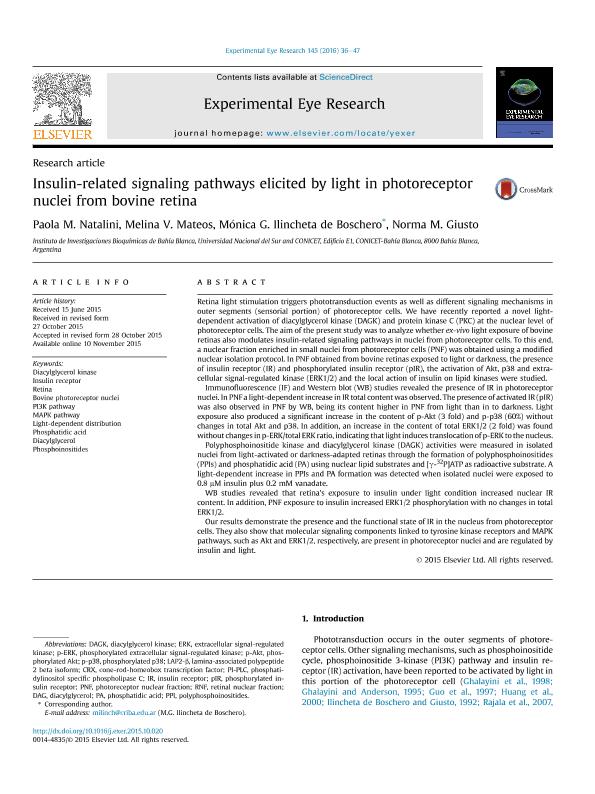Mostrar el registro sencillo del ítem
dc.contributor.author
Natalini, Paola Marisel

dc.contributor.author
Mateos, Melina Valeria

dc.contributor.author
Ilincheta, Monica Graciela

dc.contributor.author
Giusto, Norma Maria

dc.date.available
2016-07-05T17:54:28Z
dc.date.issued
2015-11
dc.identifier.citation
Natalini, Paola Marisel; Mateos, Melina Valeria; Ilincheta, Monica Graciela; Giusto, Norma Maria; Insulin-related signaling pathways elicited by light in photoreceptor nuclei from bovine retina; Elsevier; Experimental Eye Research; 145; 11-2015; 36-47
dc.identifier.issn
0014-4835
dc.identifier.uri
http://hdl.handle.net/11336/6363
dc.description.abstract
Retina light stimulation triggers phototransduction events as well as different signaling mechanisms in outer segments (sensorial portion) of photoreceptor cells. We have recently reported a novel lightdependent activation of diacylglycerol kinase (DAGK) and protein kinase C (PKC) at the nuclear level ofphotoreceptor cells. The aim of the present study was to analyze whether ex-vivo light exposure of bovine retinas also modulates insulin-related signaling pathways in nuclei from photoreceptor cells. To this end, a nuclear fraction enriched in small nuclei from photoreceptor cells (PNF) was obtained using a modified nuclear isolation protocol. In PNF obtained from bovine retinas exposed to light or darkness, the presence of insulin receptor (IR) and phosphorylated insulin receptor (pIR), the activation of Akt, p38 and extracellularsignal-regulated kinase (ERK1/2) and the local action of insulin on lipid kinases were studied. Immunofluorescence (IF) and Western blot (WB) studies revealed the presence of IR in photoreceptor nuclei. In PNF a light-dependent increase in IR total contentwas observed. The presence of activated IR (pIR)was also observed in PNF by WB, being its content higher in PNF from light than in to darkness. Light exposure also produced a significant increase in the content of p-Akt (3 fold) and p-p38 (60%) without changes in total Akt and p38. In addition, an increase in the content of total ERK1/2 (2 fold) was foundwithout changes in p-ERK/total ERK ratio, indicating that light induces Translocation of p-ERK to the nucleus.Polyphosphoinositide kinase and diacylglycerol kinase (DAGK) activities were measured in isolated nuclei from light-activated or darkness-adapted retinas through the formation of polyphosphoinositides (PPIs) and phosphatidic acid (PA) using nuclear lipid substrates and [gamma-32P]ATP as radioactive substrate. Alight-dependent increase in PPIs and PA formation was detected when isolated nuclei were exposed to 0.8 mM insulin plus 0.2 mM vanadate.WB studies revealed that retina´s exposure to insulin under light condition increased nuclear IR content. In addition, PNF exposure to insulin increased ERK1/2 phosphorylation with no changes in total ERK1/2.Our results demonstrate the presence and the functional state of IR in the nucleus from photoreceptor cells. They also show that molecular signaling components linked to tyrosine kinase receptors and MAPK pathways, such as Akt and ERK1/2, respectively, are present in photoreceptor nuclei and are regulated by insulin and light.
dc.format
application/pdf
dc.language.iso
eng
dc.publisher
Elsevier

dc.rights
info:eu-repo/semantics/openAccess
dc.rights.uri
https://creativecommons.org/licenses/by-nc-nd/2.5/ar/
dc.subject
Light
dc.subject
Photoreceptor Nuclei
dc.subject
Signaling Pathways
dc.subject
Insulin
dc.subject
Diacylglycerol
dc.subject
Mapk Pathway
dc.subject
Pl3k Pathway
dc.subject
Phosphatidic Acid
dc.subject
Retina
dc.subject.classification
Bioquímica y Biología Molecular

dc.subject.classification
Ciencias Biológicas

dc.subject.classification
CIENCIAS NATURALES Y EXACTAS

dc.title
Insulin-related signaling pathways elicited by light in photoreceptor nuclei from bovine retina
dc.type
info:eu-repo/semantics/article
dc.type
info:ar-repo/semantics/artículo
dc.type
info:eu-repo/semantics/publishedVersion
dc.date.updated
2016-05-10T14:31:26Z
dc.journal.volume
145
dc.journal.pagination
36-47
dc.journal.pais
Estados Unidos

dc.journal.ciudad
Amsterdam
dc.description.fil
Fil: Natalini, Paola Marisel. Consejo Nacional de Investigaciones Cientificas y Técnicas. Centro Científico Tecnológico Bahia Blanca. Instituto de Investigaciones Bioquímicas Bahia Blanca (i); Argentina
dc.description.fil
Fil: Mateos, Melina Valeria. Consejo Nacional de Investigaciones Cientificas y Técnicas. Centro Científico Tecnológico Bahia Blanca. Instituto de Investigaciones Bioquímicas Bahia Blanca (i); Argentina
dc.description.fil
Fil: Ilincheta, Monica Graciela. Consejo Nacional de Investigaciones Cientificas y Técnicas. Centro Científico Tecnológico Bahia Blanca. Instituto de Investigaciones Bioquímicas Bahia Blanca (i); Argentina
dc.description.fil
Fil: Giusto, Norma Maria. Consejo Nacional de Investigaciones Cientificas y Técnicas. Centro Científico Tecnológico Bahia Blanca. Instituto de Investigaciones Bioquímicas Bahia Blanca (i); Argentina
dc.journal.title
Experimental Eye Research

dc.relation.alternativeid
info:eu-repo/semantics/altIdentifier/doi/10.1016/j.exer.2015.10.020
dc.relation.alternativeid
info:eu-repo/semantics/altIdentifier/doi/http://dx.doi.org/10.1016/j.exer.2015.10.020
dc.relation.alternativeid
info:eu-repo/semantics/altIdentifier/pmid/26551282
dc.relation.alternativeid
info:eu-repo/semantics/altIdentifier/url/http://www.sciencedirect.com/science/article/pii/S0014483515300580
Archivos asociados
